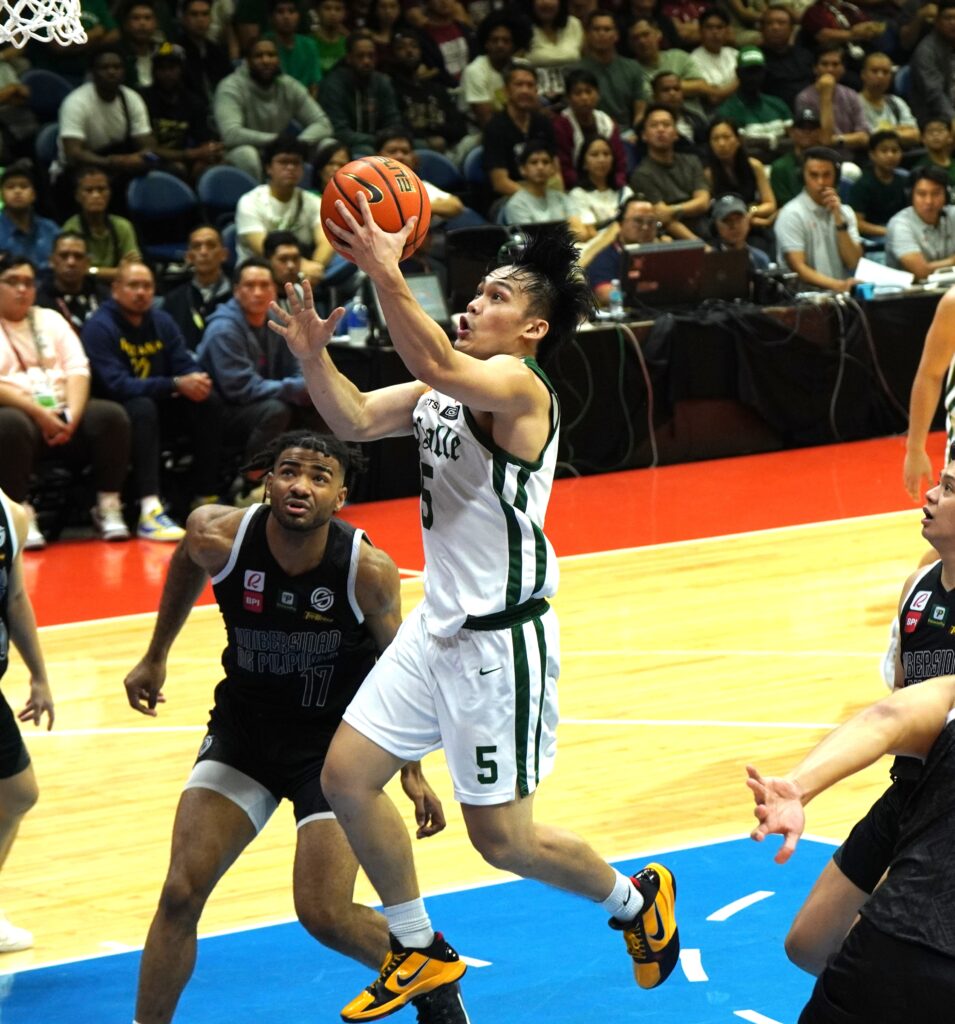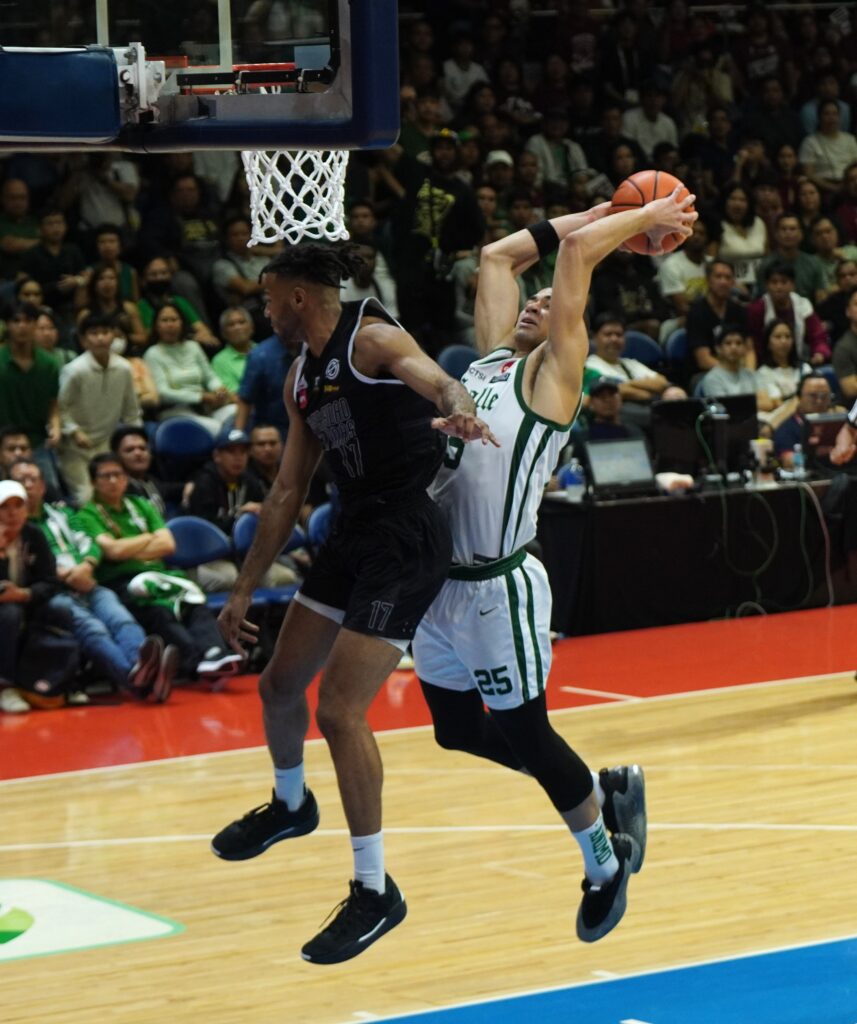
It has been written since the beginning of Season 87 that the championship rematch is bound to happen between this season’s two heavyweights, and it was only a matter of when.
The De La Salle Green Archers kicked out the Adamson Falcons in the semis, and UP dismissed UST to arrange one of the most anticipated finals rematches for the ages.
Amidst the celebration of entering the finals the second time in just his second year, Coach Topex Robinson snapped the celebratory atmosphere and tempered overconfidence by bluntly stating that La Salle has yet to face a fully healthy UP squad.
“We have not faced them in full force. Remember, we lost to UP twice during the pre-season, which is a challenge for us when we move to the finals.”
While it’s true that the Maroons have been without key contributors in their previous encounters opposite the Green Archers, it’s also evident that La Salle has been playing peak basketball against them—just as they did in their Round 1 and Round 2 matchups with UP.
Let’s zoom into the details of those games.

Round 1: La Salle’s Late Surge
In their first meeting, La Salle got off to a strong start, taking an early 20-point lead and appearing to be in total control of the game. However, UP quickly regained their mojos and chipped away at the Green Archers’ advantage as the second half unfolded.
Unlike their pre-season championship meltdown, La Salle regained their poise in the final stretch. Instead of sputtering, La Salle relinquished control in the 5-minute mark, decisively surging ahead with an 11-point lead, 62-51. They maintained their composure in the closing moments, sealing a 68-56 victory.
Harold Alarcon went solo in his fight for UP and finished with 19 points. But despite his efforts, the Maroons struggled without their primary playmaker, JD Cagulangan, who was sidelined for this game.
The Taft Avenue Archers shot a superior 93.3% from the charity line (14-of-15) and dominated the boards with 49 total rebounds (17 offensive), both of which were key contributors to winning the game. On the other side of the floor, the vaunted La Salle defense forced UP to shoot horribly from beyond the arc—just 2-of-20 from three-point range (10%)—thus preventing them from mounting a comeback. Despite 22 points in the paint and 16 bench points, UP couldn’t overcome La Salle’s all-around consistency.

Round 2: Green Archers Pull Away Late Again
In the second meeting, the game was tied at 51 entering the fourth quarter. Once again, La Salle turned up the defensive intensity and offensive fluidity, opening the final frame with an 11-2 run to seize the lead.
From there, they held firm, closing out a 77-66 win. La Salle shot 47.5% from the field (29-of-61) and racked up 21 assists, displaying smooth ball movement and finding high-quality shots throughout the game. On the flip side, UP, shooting 44.1% from the field, struggled from long distance, making only 15.8% of their three-point attempts (3-of-19).
And once again, La Salle’s depth was the difference maker. While UP relied heavily on Cagulangan (22 points) and Alarcon, the Green Archers had a number of players step up. Josh David contributed 14 points, 8 of which came in the second half, while Kevin Quiambao added 16 points. Despite solid bench contributions from UP (14 points), La Salle’s well-rounded approach proved too much. The Green Archers’ bench outscored UP’s 27 to 14.

LA SALLE TEAM PLAY VS. UP’S DRIBBLE-DRIVE
La Salle’s offense thrives on constant movement and ball sharing, a principle they executed perfectly in both matchups. They averaged 18.8 assists per game during the regular season, but in these two games, they notched 20 assists in Round 1 and 21 assists in Round 2, consistently moving the ball and finding the best available shot. This unselfish ball movement neutralized UP’s defense, especially their attempts to double-team and focus on limiting La Salle’s stars.
In these UP matches and for all their 14 regular season games, 77% of the field conversions were products of assists just to flex the team ball philosophy of the Green Archers.
UP, on the other hand, remains heavily reliant on Cagulangan and Alarcon for those dribble pull-ups. It was evident in both matchups that when the offense of the two guards cratered, the Maroons struggled.
In Round 1, Alarcon poured in 15 of his 19 points in the second half, but his efforts weren’t enough to compensate for the absence of Cagulangan and the lack of other reliable scoring options.
In Round 2, Cagulangan finished with 22 points, but again, the Maroons’ offense begged for consistent support from other players. No one else reached double digits outside their two stars in either game.
The reason?
This edition of Green Archers was a team built to counter UP’s strengths. With every Cagulangan and Alarcon, Topex has EJ Gollena and JC Macalalag as defensive answers. These tall and agile wings have the lateral agility of a guard plus the physical gifts to shut down these UP guards, even at top speed.

The Key Stats: La Salle’s All-Around Dominance
In both matchups, La Salle’s depth and all-around play were the key factors. In Round 1, the Green Archers posted 49 rebounds (17 offensive) and 21 assists, while UP finished with just 40 rebounds and 8 assists. In Round 2, La Salle again outpaced UP with 48 rebounds (12 offensive) and 21 assists, compared to UP’s 41 rebounds and 7 assists. La Salle’s unselfish ball movement and relentless offensive attack proved too much for UP, with their depth allowing them to maintain a high level of play.

La Salle’s Dominance on the Boards
One of the most glaring differences between the two teams was on the glass. La Salle controlled the boards in both games, hauling in 17 offensive rebounds in Round 1 and 12 in Round 2. These second-chance opportunities were critical, with La Salle scoring 10 points off offensive rebounds in Round 1 and 8 in Round 2. In contrast, UP managed only 5 second-chance points in Round 1 and 6 in Round 2, and their inability to capitalize on those extra possessions contributed to their struggles.
Motor Mike Phillips’ limitless energizer bunny efforts remain to be the muscle behind De La Salle rebounding, grabbing 11.5 rebounds a game.
La Salle was also more effective in transition, recording 7 fast break points in Round 2 compared to just 3 for UP. This allowed La Salle to go run and gun, the pace of basketball Topex really loves.

THAT DEFENSIVE EDGE
The green and white defense has been brilliant and efficient, making great reads on coverage and blitzes. Being gifted with defenders who are lightning-quick to recover and can vertically pop in a split-second to contest every lay-up has been a blessing to Coach Topex.
This has allowed the De La Salle defense to challenge three-point shooters while having the security to defend the interior. As a result, La Salle is the league’s number one team in closing out on the three, only allowing 22.36% from their opponents and only 73 triples the entire 14 games. While their opponent can only shoot five three-pointers per game, La Salle has effectively denied easy inside baskets with their length and insane vertical.
SO, WHO HAS THE EDGE?
La Salle’s depth, ball movement, and team-oriented play were simply too much for UP in both matchups. Despite strong individual performances from Alarcon and Cagulangan, UP couldn’t generate enough scoring from their supporting players. At the same time, La Salle’s balanced attack, control of the boards, and unselfish distribution gave them the advantage.
Comparing the two teams over the course of their 14 games, the stats are almost identical:

Will the presence of QMB and Cagulangan on the floor simultaneously make a significant difference?
Or will La Salle play the same aggressive brand of defense and strut their stellar team ball on the other end? Will KQ continue to dominate the game, or will other Green Archers step up?
Game One is coming up this Sunday, December 8, 2024, and we cannot wait for the 6:30pm tip-off.
ANIMO LA SALLE!

